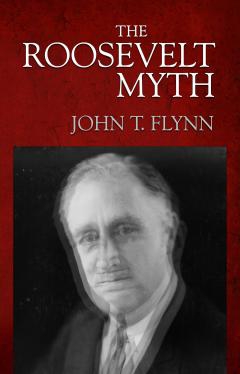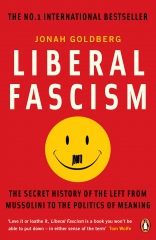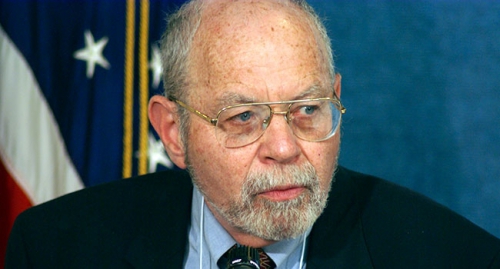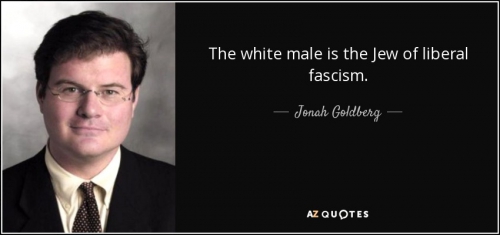At the recent Scholars’ Conference (sponsored by the L von M Institute) I asserted that while anti-New Deal commentators between the two wars were not entirely wrong in their analysis of fascism, current attempts to identify fascism with the Left are rarely more than GOP rhetoric. Since this point may have puzzled my listeners, it may be helpful to explain what my statement meant. My clarification may be all the more necessary since I said roughly the same thing on Tom Woods’s radio program, without going into details. In the 1930s and 1940s, such critics of the New Deal and FDR’s liberal internationalism as John T. Flynn, Albert J. Nock, Garet Garrett and Frank Chodorov were fond of associating the politics of the American government with European fascism. This criticism went back to the 1930s and in the case of Flynn, was originally aimed at the Italian fascist regime. Flynn and his followers feared that fascism, which like the New Deal offered a halfway house between capitalism and socialism, was more insidious for the West than Communism: “A man could support publicly and with vehemence this system of the Planned Economy without incurring the odium of being too much of a radical for a polite and practical society.” Fascism with its “Planned Capitalism,” insisted Flynn, was the “direct opposite of liberalism.” (Flynn in this passage was using the word liberal in its true historical sense.) This newly conceived regime was “an attempt, somewhere between Communism and capitalism, to organize a stable society and to do it by setting up a state equipped with massive powers over the lives and fortunes of its citizens.”
 Flynn’s still highly readable The Roosevelt Myth includes accurate, well-phrased observations, however much they may overestimate the staying power of the fascist model. But in his assumption that the fascist state would have long-term appeal, Flynn was hardly alone. In 1933, FDR and his Brain Truster Rexford Tugwell thought that fascism would be here to stay, and as late as 1940, James Burnham viewed it as one of the several forms of the modern administrative state —and possibly the most successful form that it would assume in the course of the twentieth century.
Flynn’s still highly readable The Roosevelt Myth includes accurate, well-phrased observations, however much they may overestimate the staying power of the fascist model. But in his assumption that the fascist state would have long-term appeal, Flynn was hardly alone. In 1933, FDR and his Brain Truster Rexford Tugwell thought that fascism would be here to stay, and as late as 1940, James Burnham viewed it as one of the several forms of the modern administrative state —and possibly the most successful form that it would assume in the course of the twentieth century.
I should also indicate at this point what Flynn and his confreres never said. They did not claim that fascists were leftists, at a time when New Dealers and the editorial board of the very leftist New Republic imagined that Mussolini was their ideological ally. Critics of the New Deal who discerned overlaps between Mussolini and FDR pointed to a shared managerial style of rule. They viewed fascist Italy and welfare-state America as related threats to a liberal society, and the fact that FDR in the early and mid-1930s, before Mussolini’s sudden about-face and alliance with Nazi Germany, expressed admiration for his Italian counterpart, seemed to prove the validity of Flynn’s comparison. I would not hold it against Flynn, Garrett, and Nock that they failed to anticipate my own arguments about Italian fascism. From their historical position, they may not have seen this development as a make-believe revolutionary movement, which came to power largely as a check on the revolutionary Left.
This was not obvious to most American observers in the 1930s, who may have been more likely to have noticed the political resemblances between fascist Italy and New Deal America. The extensive labor legislation introduced in America in the 1930s looked at least on paper like the “Labor Charter” introduced by Mussolini’s government in 1926. The pump-priming efforts undertaken by both governments to deal with the Great Depression were noticeably similar. Nor was there any reason in the early or mid- 1930s or perhaps even later for an intelligent foreign observer to think that fascism would soon be on its way out. By the early 1930s, there was a “fascist international” that sought to compete with the Communist movement for support throughout the world. Italian fascist journalists were then taking the side of indigenous populations against English colonialism. (The Italian fascist government generally viewed England as their main rival; however between 1933 and 1936 Mussolini’s hostility was transferred temporarily to Nazi Germany.)
 While New Deal critics tried to understand fascism in their time, today’s GOP propagandists do not try to understand anything about this interwar movement. They make their living by labeling the Democrats “fascists” and then identifying fascism and the Democrats with the Left. Jonah Goldberg’s best-selling pseudo-scholarship Liberal Fascism (2007) may be the most popular example of this propaganda technique but (alas) Goldberg’s nonsense is far from the worst of its genre. In researching my monograph, I unearthed so many abuses of the “f” word by GOP publicists and conservatism, inc., that I finally gave up cataloging them. I also discovered that no one (except perhaps for old-fashioned Habsburg monarchists) really believes that “fascism” was or is a leftist movement. When neocons start screaming about “Islamofascism,” I doubt that they’re suggesting that Muslim terrorists and multicultural Americans are ideological soulmates.
While New Deal critics tried to understand fascism in their time, today’s GOP propagandists do not try to understand anything about this interwar movement. They make their living by labeling the Democrats “fascists” and then identifying fascism and the Democrats with the Left. Jonah Goldberg’s best-selling pseudo-scholarship Liberal Fascism (2007) may be the most popular example of this propaganda technique but (alas) Goldberg’s nonsense is far from the worst of its genre. In researching my monograph, I unearthed so many abuses of the “f” word by GOP publicists and conservatism, inc., that I finally gave up cataloging them. I also discovered that no one (except perhaps for old-fashioned Habsburg monarchists) really believes that “fascism” was or is a leftist movement. When neocons start screaming about “Islamofascism,” I doubt that they’re suggesting that Muslim terrorists and multicultural Americans are ideological soulmates.
By this point fascism is not an ideological reference point but the verbal equivalent of a chair that one throws at one’s enemy’s head. Just a few minutes ago, I found this substantiated when neoconservative luminary Robert Kagan announced that “Trump will bring fascism to America.” Finally, I can’t believe that anyone but a total idiot would imagine that American affirmative action programs (when enforced by Democrats but supposedly not Republicans) resemble Hitler’s exclusion of Jews from professions and from German citizenship during the 1930s. When I encountered this comparison in Goldberg’s turgid screed, I remember saying to myself I hope he’s joking or simply lying to sell books to Dittoheads. Any other reason for his lunatic statements is too scary to consider.
In any case, I get exasperated by those who try to trace Goldberg’s opinions back to Flynn and other anti-New Deal critics of fascism. Contrary to what is suggested in the introductory chapter of Fascism: Career of a Concept Goldberg and his fellow-publicists in the GOP establishment are not offering an interpretation of fascism that goes back to the interwar American Right. These specialists in PR have never thought seriously about the “f” word and happily run together Italian fascism, German Nazis, Hillary Clinton and whatever else the GOP establishment is currently running against. By contrast, Flynn and others of his time and persuasion were better-informed analysts. Their critical commentaries on the “fascist revolution” and its relation to the New Deal are still worth revisiting.






 del.icio.us
del.icio.us
 Digg
Digg
Les commentaires sont fermés.